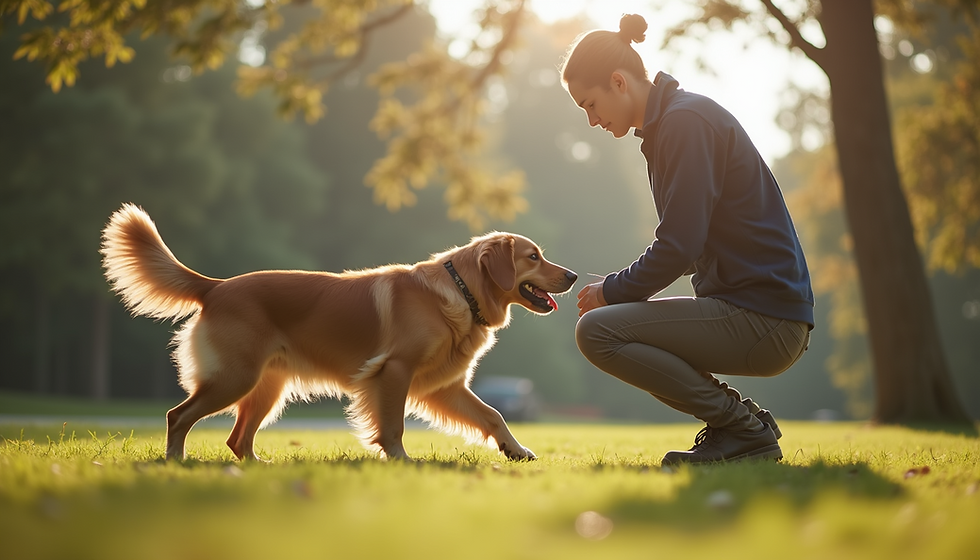A Step-by-Step Puppy Training Schedule
- Larry Benoit
- Aug 12
- 4 min read
Bringing a new puppy home is an exciting experience filled with joy and anticipation. However, it also comes with the responsibility of training your furry friend to become a well-behaved member of your family. Establishing a puppy training routine early on is essential for building good habits and ensuring your puppy grows into a confident, obedient dog. This guide will walk you through a detailed, step-by-step puppy training routine that covers everything from basic commands to socialization and housebreaking.
Creating an Effective Puppy Training Routine
Starting with a clear and consistent routine helps your puppy understand what is expected. Puppies thrive on structure, and a well-planned schedule reduces confusion and anxiety.
Morning Session: Basic Commands and Potty Training
Begin your day with a potty break immediately after your puppy wakes up. Puppies have small bladders and need frequent bathroom breaks. Take your puppy outside to the same spot each time to encourage association.
After the potty break, spend 10-15 minutes on basic commands such as "sit," "stay," and "come." Use positive reinforcement techniques like treats and praise to motivate your puppy. Keep training sessions short and fun to maintain their attention.
Midday Session: Socialization and Playtime
Socialization is critical during the first few months. Introduce your puppy to different environments, sounds, and people. Arrange playdates with vaccinated dogs or visit dog-friendly parks to expose your puppy to new experiences. Puppy shots are required for the dog park.
Incorporate playtime with interactive toys to stimulate your puppy mentally and physically. This helps prevent boredom and destructive behavior.
Evening Session: Crate Training and Relaxation
Crate training provides your puppy with a safe space and aids in housebreaking. Introduce the crate gradually by placing treats and toys inside. Encourage your puppy to enter voluntarily and reward them for calm behavior.
End the day with a calm bonding session, such as gentle petting or brushing. This helps your puppy wind down and associate the crate with comfort.

Understanding the Importance of Consistency in Your Puppy Training Routine
Consistency is the cornerstone of successful puppy training. Without it, your puppy may become confused about rules and expectations.
Set specific times for feeding, potty breaks, and training sessions.
Use the same commands and cues every time.
Ensure all family members follow the same rules and training methods.
Keep training sessions short but frequent to reinforce learning.
By maintaining a consistent routine, your puppy will quickly learn what behaviors are acceptable and which are not. This reduces frustration for both you and your puppy.
Tips for Maintaining Consistency
Use a daily planner or app to schedule training and potty breaks.
Prepare treats and training tools in advance.
Celebrate small victories to stay motivated.

What is the 7 7 7 Rule for Dogs?
The 7 7 7 rule is a helpful guideline for new dog owners to understand their puppy’s development and training needs. It breaks down into three key stages:
7 weeks: This is when puppies are typically weaned and ready to start basic training and socialization.
7 months: At this age, puppies reach adolescence and may test boundaries. Consistent training is crucial to reinforce good behavior.
7 years: Dogs are considered mature adults. Training should continue to maintain obedience and mental stimulation.
Understanding this timeline helps you tailor your training approach to your puppy’s developmental stage. For example, early socialization at 7 weeks can prevent fearfulness later, while patience and persistence are needed during the challenging adolescent phase.
Applying the 7 7 7 Rule in Your Routine
Start socialization and basic commands at 7 weeks.
Increase training intensity and introduce more complex commands by 7 months.
Maintain regular training and mental exercises throughout your dog’s life.

Housebreaking Your Puppy: Step-by-Step Guide
Housebreaking is one of the first challenges new puppy owners face. A structured approach makes this process smoother.
Establish a designated potty area outside.
Take your puppy out frequently: after waking, eating, playing, and before bedtime.
Use a consistent command like "go potty" to create an association.
Reward your puppy immediately after it eliminates outside.
Supervise indoors to prevent accidents.
Clean accidents thoroughly to remove odors that might attract repeat behavior. Use an enzyme killer to clean up with, like Resolve.
Patience is key. Puppies may have accidents, but with consistent training, they will learn quickly.
Advanced Training Tips to Enhance Your Puppy’s Skills
Once your puppy masters basic commands, you can introduce more advanced training to keep them engaged and well-behaved.
Leash training: Teach your puppy to walk calmly on a leash without pulling.
Impulse control: Practice commands like "leave it" and "wait" to improve self-control.
Trick training: Fun tricks like "roll over" or "shake" provide mental stimulation.
Recall training: Ensure your puppy reliably comes when called, even with distractions.
Incorporate these exercises into your daily routine to build a strong bond and a well-mannered dog.
Resources for Ongoing Puppy Training Success
Training a puppy is an ongoing journey. Utilize resources such as books, online courses, and professional trainers to support your efforts. For detailed guidance and expert advice, consider exploring a comprehensive puppy training schedule that fits your lifestyle.
By following a structured routine and adapting as your puppy grows, you will set the foundation for a happy, obedient companion.
Starting your puppy on a consistent training routine is the best gift you can give them. With patience, consistency, and positive reinforcement, your puppy will develop into a well-behaved and joyful member of your family. Keep training sessions fun and rewarding, and enjoy the special moments along the way.



Comments